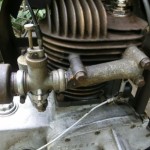Home › Forums › General › Help and information › Villiers coil readings
- This topic has 9 replies, 6 voices, and was last updated 4 years, 1 month ago by
rowan-bradley.
-
AuthorPosts
-
November 23, 2016 at 1:38 pm #23182
 vhgmcbuddyMember
vhgmcbuddyMemberHaving no spark on my clifford mk1 rotavator I have taken the magneto out to take a closer look. All seems clean and operational. Having tested the coil I’m getting 0.4 on the primary (set at 200 ohms) and 2.55 on the secondary (set at 20k). Does anyone know what the readings should be for a villiers mk 25 c? Do these readings look ok?
November 23, 2016 at 5:54 pm #23185andyfrost
ParticipantI’ve said it countless times on here , you can’t test a coil PROPERLY with anything other than a purpose built ignition tester , your local mower/small engine centre should have one.
Andy.
November 24, 2016 at 9:24 am #23200 charlieKeymaster
charlieKeymasterThe problem with a simple resistance check is it cannot take account of running conditions ie insulation can break down as soon as coil starts working. If a good clean of points and mating surfaces between coil and backplate etc does not give a good spark, I replace coil, points and condenser, not a cheap option but it does ensure a good spark. Do not buy cheap or secondhand coils.
November 24, 2016 at 2:49 pm #23201 vhgmcbuddyMember
vhgmcbuddyMemberThank you both. I have decided to take the magneto to The Mower Centre in Hailsham to be tested as I’m not too far from there and they can supply any replacement parts needed.
November 24, 2016 at 4:00 pm #23203 wristpinParticipant
wristpinParticipantI 100% endorse the need for proper coil testing. Stressing the coil with a proper tester will soon show up internal breakdowns of insulation and frequently on Villiers engines. ” leakage” between the HT termination of the coil and the magneto backplate; so best to test the magneto as an assembly and not just the coil. If a test of the mag gives a negative result it is then worth doing a separate test of the condenser. This can be done in situ but it is necessary to separate the condenser wire from the coil primary wire and Make sure that the points are either open or disconnected.
November 24, 2016 at 5:47 pm #23204 vhgmcbuddyMember
vhgmcbuddyMemberAppreciate all the help. Though I used to tinker with motorbikes, I’m only just getting back into such things after many years.
Does anyone want to talk me through setting the timing and points on a villiers mk25 c? (It’s on a clifford mk1 rotavator)
There is an arrow on the flywheel, one on the back plate (at about 11 o clock) and one at the end of the countershaft. In my research I seem to be getting conflicting ideas as to what lines up with what!November 24, 2016 at 7:40 pm #23206 stuartParticipant
stuartParticipantFirst set the points gap to 012″-015″.Then loosen the flywheel on the crankshaft.Position the piston at TDC (the mark on the very end of the crankshaft will be at 12 o clock when piston is at TDC).Turn the flywheel so that its mark / arrow is opposite the mark on the alloy backplate.When turning the flywheel and also when retightening it the crankshaft must NOT move.With this done the timing will be set at 5/32″ BTDC.
November 24, 2016 at 11:24 pm #23214 wristpinParticipant
wristpinParticipantThe attached may be of assistance but it doesn’t mention arrows. You mention “countershaft” should that be crankshaft? Quite a lot of Villiers engines that I’ve seen have a small notch in the flywheel end of the crank which, when at 12 o’clock coincides with top dead centre. You may find that the arrow on your flywheel, when lined up with the one on the backplate and the piston at TDC, is the position at which the points should just start to open. Please note the use of may!
Personally I like to set the timing from basic principles ie setting the piston to the specified distance before TDC and the flywheel to just start to open the points. If you do this and then look at the relative positions of the arrows all may become clear!https://www.dropbox.com/s/sk6uyq6i5e700xg/Villiers%20Mk25%20service%20and%20repair0001.pdf?dl=0
November 25, 2016 at 12:20 am #23215 vhgmcbuddyMember
vhgmcbuddyMemberThank you – This is starting to make sense and yes wristpin, I did mean crankshaft! (I was still in Trusty mode – working on both at the moment). Thanks for the link.
Stuart, your explanation is very clear. I did have a fiddle before reading your post and managed to get some sort of spark, so must be getting close. I will now re-examine the settings to make sure I got it right.October 26, 2021 at 7:00 pm #38149rowan-bradley
ParticipantI know this is a very old post and is probably of no interest to anyone, and I know the recommendations to get a proper magneto test done, but for interest, these resistance readings are very similar to the ones I got today from my coil (from an Allen scythe with Villers 25c engine): 0.5 ohms for the primary, and 2.72K for the secondary.
Rowan
-
AuthorPosts
- You must be logged in to reply to this topic.

